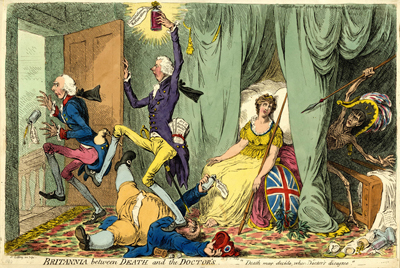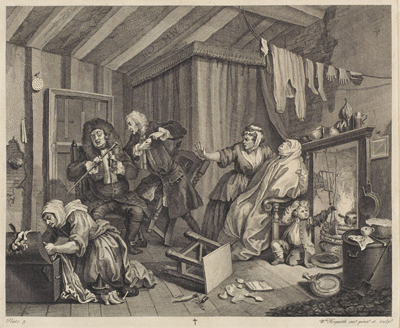Britannia between Death and the Doctor's
One of Gillray's most brilliant and effective prints, Britannia between Death and the Doctor's plays upon two meanings of "constitution" to show William Pitt literally kicking Prime Minister Henry Addington out of his job as the chief guardian of Britannia's health/constitution while stepping squarely upon the opposition leader, Charles James Fox, in doing so.

© Trustees of the British Museum
The print was prompted by the replacement of Prime Minister Henry Addington (the son of a doctor) on May 10 with William Pitt, who had led a coalition of opponents to Addington's ministry. (See Gillray's Confederated Coalition, or The Giants Storming Heaven published earlier in the month.) Although the Treaty of Amiens negotiated by Addington in 1802 had provided a much needed respite from the war between England and France, it had become increasingly clear that Napoleon had simply used the time to rebuild his forces. To Pitt and others, Addington's wait and see policy seemed much too passive an approach to the growing threat. In Gillray's print, then, the "Composing Draft" which Addington has been administering to his patient has left her sleepy, prostrate, and exposed to Napoleon's attack. Indeed, all of the "Prescriptions" signed by Addington from the table on the right have been overturned by Napoleon's unmistakably warlike posture.
In actuality, Pitt had planned to assemble a coalition ministry with Fox as Foreign Minister. But the strenuous objections of the King prevailed and the "Constitutional Restorative" of a new Pitt ministry (the bottle significantly topped by a crown) effectively quashed any ambitions Fox might have had. To the King, (as to Gillray) Fox was still the bonnet rouge supporter of France proferring nothing more than sweet smelling "Republican balsam." The Whig Pills (looking suspiciously like dice), would also have reminded one that Fox was the same dissipated gambler who had led the Prince of Wales astray. The papers protruding from Pitt's pocket, "Art of Restoring Health" may allude to the then popular work by Thomas Beddoes, A Series of Popular Essays on the Means of Preserving and Restoring Health. (1804)

© Lewis Walpole Library, Yale University
The satiric point made in the subtitle, "Death may decide when Doctors disagree" was a common theme in caricature. Indeed, I can't help thinking that in creating this print Gillray was remembering the fifth plate of Hogarth's Harlot's Progress (1732). The squabbling doctors in both are completely oblivious to their supposed patient. Both Moll and Britannia are supported in an upright position but near death. The overturned tables in both prints display the ineffective remedies that have already been tried.
But in 1804 British citizens needed no reminders. They would have been all too familiar with dueling doctors and royal patients from their own experience with the varying and conflicting bulletins about the King's madness in 1788-89 and with its recurrence in 1804. And the locket around Britannia's neck inscribed with the King's profile and "Georgius III Rex" would have confirmed for them that King George and Britannia were inextricably connected and both were in danger
Sources and Reading
- Commentary from the British Museum on Britannia between Death and the Doctor's
- Draper Hill, Mr. Gillray The Caricaturist, 1965, p. 130.
- Draper Hill, The Satirical Etchings of James Gillray, 1976, #81.
- "William Pitt the Younger," Wikipedia
- "Henry Addington, 1st Viscount Sidmouth," Wikipedia
- "Charles James Fox," Wikipedia
- Thomas Wright and R.H. Evans, Historical and Descriptive Account of the Caricatures of James Gillray #301.
Comments & Corrections
NOTE: Comments and/or corrections are always appreciated. To make that easier, I have included a form below that you can use. I promise never to share any of the info provided without your express permission.